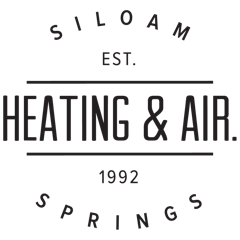
You shouldn’t need to give up comfort or drain your wallet to keep your house at a pleasant temp during warm days.
But what is the ideal temp, exactly? We discuss suggestions from energy professionals so you can determine the best temperature for your loved ones.
Here’s what we suggest for the most energy-efficient setting for air conditioning in Siloam Springs.
Recommended Thermostat Settings for Summer
Most households find placing the thermostat at 72-73 degrees is ideal. However, if there’s a big difference between your inside and exterior warmth, your cooling bills will be higher.
This is our advice based on the U.S. Department of Energy (DOE) and ENERGY STAR®.
While at home: 78 degrees. While that sounds hot, there are ways you can keep your house pleasant without having the air conditioning on frequently.
Keeping windows and window treatments closed during the day keeps cool air where it belongs—within your home. Some window treatments, including honeycomb shades or plantation shutters, are made to give more insulation and improved energy efficiency.
If you have ceiling fans in your home, the DOE says you can increase thermostat settings about 4 degrees warmer without sacrificing comfort. That’s due to the fact they freshen with a windchill effect. As they cool people, not areas, turn them off when you move from a room.
If 78 degrees still seems too uncomfortable on the surface, try conducting a trial for approximately a week. Start by increasing your thermostat to 78 degrees while you’re home. Then, gradually decrease it while following the ideas above. You might be shocked at how comfortable you feel at a higher temperature setting.
While away: 88 degrees. There’s no rationale for keeping the air conditioner working all day while your residence is empty. Moving the setting 7–10 degrees hotter can save you an estimated 5–15% on your cooling expenses, according to the DOE.
When you arrive home, don’t be tempted to set your thermostat under 78 to cool your house more quickly. This isn’t effective and typically produces a more expensive AC bill.
A programmable thermostat is a helpful approach to keep your temperature controlled, but it requires setting programs. If you don’t use programs, you risk forgetting to raise the set temperature when you go.
If you need a handy resolution, consider getting a smart thermostat. This thermostat connects with your phone, so it realizes when you’re at home and when you’re out. Then it intuitively modifies temperature settings for the biggest savings. How much exactly? Usually $180 each year on heating and cooling, according to ENERGY STAR.
Another advantage of getting a smart thermostat? You can use your phone to watch and regulate temperature settings from almost anywhere.
While sleeping: Around 70 degrees. While ENERGY STAR suggests 82 degrees, that could be unpleasant for the majority of families. The majority of people sleep better when their sleeping space is chilled, so that’s why the National Sleep Foundation suggests 60–67 degrees. But that may be too chilly, due to your clothing and blanket preference.
We recommend running an equivalent test over a week, setting your temp higher and steadily turning it down to find the best setting for your house. On pleasant nights, you might discover keeping windows open at night and running a ceiling fan is a superior idea than using the air conditioning.
More Methods to Use Less Energy This Summer
There are added methods you can spend less money on utility bills throughout warm weather.
- Get an energy-efficient cooling system. Central air conditioners only work for about 12–15 years and get less efficient as they become older. A new air conditioner can keep your home more comfortable while keeping electricity expenses low.
- Book annual air conditioner tune-ups. Regular air conditioner maintenance keeps your unit operating like it should and may help it run more efficiently. It might also help prolong its life expectancy, since it allows pros to spot little troubles before they lead to a major meltdown.
- Replace air filters frequently. Read manufacturer instructions for switching your air filter. A dirty filter can cause your system to short cycle, or switch on and off too much, and raise your electricity.
- Check attic insulation levels. Just about 90% of residences in the U.S. don’t have adequate insulation, according to the Insulation Institute. Many southern climates require 13–14” of attic insulation, while northern climates need 16–18”.
- Have your ductwork examined. Ductwork that has come apart over time can let conditioned air into your attic, walls or crawl space. This can result in big comfort troubles in your house, like hot and cold spots.
- Seal openings, doors and windows. Keep hot air in its place by sealing holes. You can also caulk or weather strip doors to keep more cold air indoors.
Conserve More Energy During Hot Weather with Siloam Springs Heating & AC
If you are looking to use less energy during hot weather, our Siloam Springs Heating & AC experts can assist you. Give us a call at 479-308-8176 or contact us online for additional info about our energy-saving cooling solutions.


